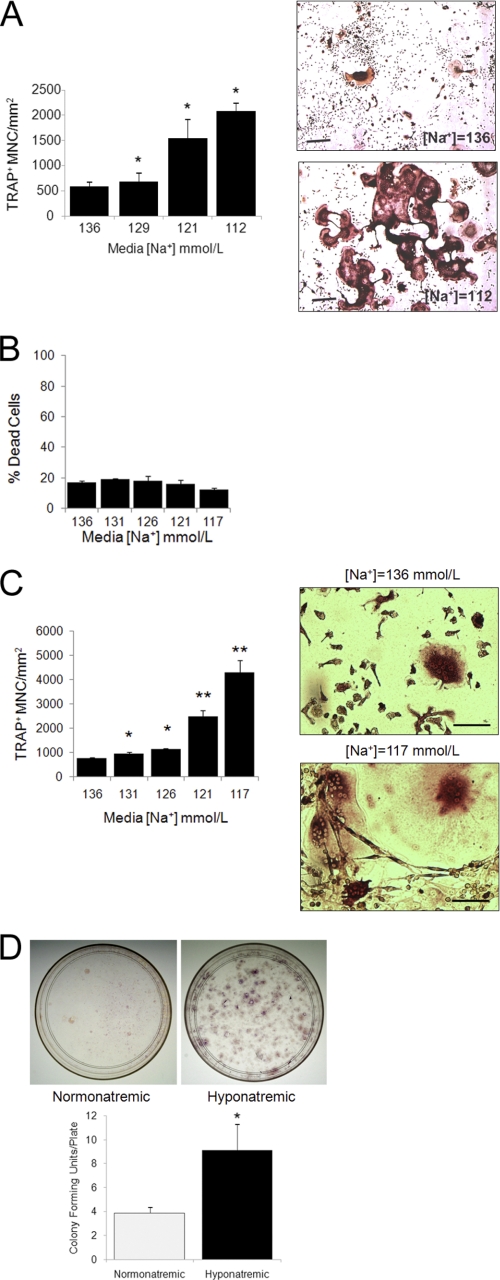FIGURE 1.
Lowering [Na+] proportionally stimulates osteoclastogenesis. A, murine RAW 264.7 monocytic cells were grown in medium with the indicated [Na+] and treated for 7 days with recombinant RANKL (50 ng/ml) and M-CSF (10 ng/ml) to induce osteoclast differentiation. After fixation, cells were stained for TRAP activity, and quantification of TRAP-positive multinucleated cells was performed in triplicate wells. The graph (top) shows that lowering the [Na+] in the medium dose-dependently increased osteoclast formation. This direct effect was significant even with mild changes in [Na+] (e.g. 129 mmol/liter), a concentration that is associated with no symptoms in most patients. Data represent means ± S.E. (error bars). *, p < 0.01 comparing samples with one-step lower [Na+]. Representative images of TRAP-positive osteoclast cultures at medium [Na+] = 136 mmol/liter and medium [Na+] = 112 mmol/liter show marked differences of TRAP-positive cell density. Scale bars, 50 μm. B, RAW 264.7 cells were adapted to grow in media with the desired [Na+]. Equal numbers of cells were transferred to 96-well plates in triplicates. Cell viability was measured using a LIVE/DEAD cell kit. Calcein fluorescence emission intensities are expressed as percentage of control (emission from cells killed by incubation with digitonin according to the manufacturer's instructions). Data are expressed as mean ± S.E. No statistically significant differences were detected in viability of cells upon lowering [Na+]. C, BMMs were prepared from femora of four Sprague-Dawley rats, and monocytes were enriched by Ficoll gradient centrifugation, plated into 12-well culture dishes, adapted, and differentiated in media with target [Na+], as depicted on the graph. After 14 days, cells were fixed and stained for TRAP and counted. Shown are representative images from cells grown in medium with [Na+] = 136 mmol/liter and [Na+] = 117 mmol/liter; TRAP activity appears as a dark brown signal. Scale bars, 10 μm. Data are expressed as means ± S.E. from triplicates. *, p < 0.01; **, p < 0.001 comparing samples with one-step lower [Na+]. D, BMMs from hyponatremic and normonatremic rats were differentiated into osteoclasts while maintaining normal or low [Na+] as appropriate. Both the [Na+] = 117 mmol/liter and the [Na+] = 136 mmol/liter media were supplemented with M-CSF and RANKL. Images from representative 10-cm culture plates and the graph indicate that low [Na+] promoted formation of more TRAP+ colonies than normal [Na+]. Data are means ± S.E.; *, p < 0.001.

